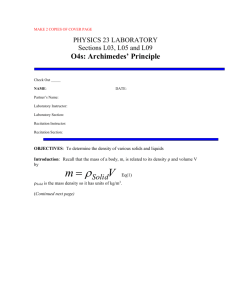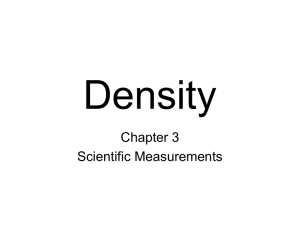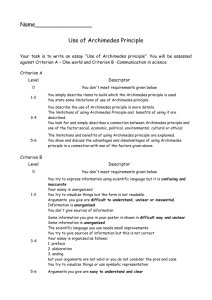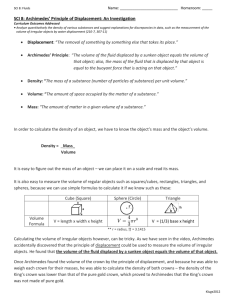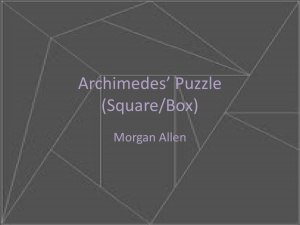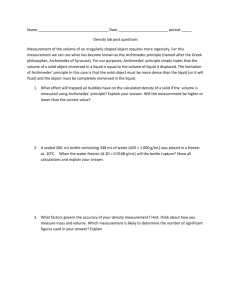Archimedes' Principle Lab Experiment: Density Measurement
advertisement
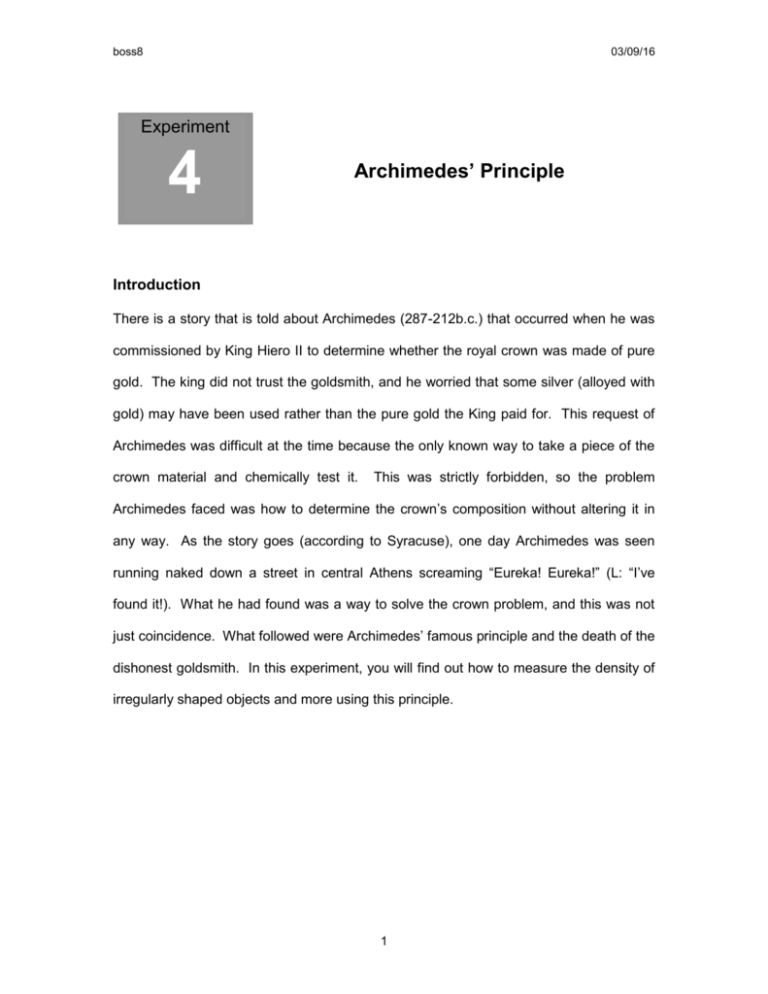
boss8 03/09/16 Experiment 4 Archimedes’ Principle Introduction There is a story that is told about Archimedes (287-212b.c.) that occurred when he was commissioned by King Hiero II to determine whether the royal crown was made of pure gold. The king did not trust the goldsmith, and he worried that some silver (alloyed with gold) may have been used rather than the pure gold the King paid for. This request of Archimedes was difficult at the time because the only known way to take a piece of the crown material and chemically test it. This was strictly forbidden, so the problem Archimedes faced was how to determine the crown’s composition without altering it in any way. As the story goes (according to Syracuse), one day Archimedes was seen running naked down a street in central Athens screaming “Eureka! Eureka!” (L: “I’ve found it!). What he had found was a way to solve the crown problem, and this was not just coincidence. What followed were Archimedes’ famous principle and the death of the dishonest goldsmith. In this experiment, you will find out how to measure the density of irregularly shaped objects and more using this principle. 1 Apparatus Zero Adjustment 0 Wood Iron Figure 1 Figure 2 Figure3 Procedure 1. Carefully zero the balance. 2. Attach the Pb cube to the bottom loop 2 - of string, bring to balance and record its mass in Table 1. 3. Add some deionized water?/tap water (do you really need to use de-ionized water? see question 1) to the beaker and carefully place the suspended Pb inside (See Figure 1). This initial water is to protect the beaker in case the Pb mass detaches from the string. 4. Add more water to the beaker to bring its level just above the Pb as shown in figure 1. 5. Balance and record the buoyant mass of Pb in Table 1. 6. Repeat steps 1 through 4 for the yellow brass cube, bolt and unknown. Be sure to clean up any water spills. Place wet objects on a paper towel to dry. 7. Attach the wood block to the upper loop of string and the yellow brass or lead cube to the bottom of the wood, and carefully lower the blocks into the beaker as instructed in step 3. 8. Now add water and fill the beaker to the level shown in figure 2, balance and record this mass as “reading #1” in Table 1. 9. Add more water until the level is as shown in figure 3, balance and record this mass as “reading #2” in Table 1. 10. Measure and record the mass of the wood block (in air) in the space below Table 1. 11. Finally, repeat 3, 4, and 5 using NaCl (aq.) in place of the water. Be particularly careful with the NaCl (aq.). Save the NaCl (aq.) in its original container and rinse everything completely with water to remove the salt residue. 2 boss8 03/09/16 Theory 1. In the space below, state Archimedes’ Principle and define density, then show mathematically how now can measure the density of an object using this principle. Be sure to draw a free-body diagram of the mass attached to the string. What does the tension in the string measure? 2. Derive an equation for determining the density of a floating/wooden object using Archimedes’ Principal. No free-body diagram is needed. 3. Finally, derive an equation using Archimedes’ Principal showing how the density of a liquid can be measured. Your expression should be in terms of the density of water, object’s mass in water, the object’s mass in NaCl solution, and the object’s mass in air (i.e. in terms of the quantities in Table 1). No free-body diagram is needed. 3 Data Density of water is 1.00g/cm 3 (3 significant figures) Substance Table 1: Density Measurements Mass (g) Buoyant Mass (g) Change in Mass (g) Lead Yellow Brass Bolt Unknown Floating object/ Wood NaCl (aq.) Reading #1 Reading #2 Mass of wood block (in air): ___________ Analysis 1. Show in detail in the space below the calculation of the density of lead using your derived equation. 2. In a similar manner, calculate the density of the object that floats. 3. Finally, show the calculation of the density of the liquid used. 4 boss8 03/09/16 Results Substance Table 2: Measured Densities Measured Density *Reference Density % Error Lead Yellow Brass Bolt Unknown Wood NaCl (aq.) *Using the handbook (or other similar references) look up and record the densities of as many of these materials as you can find. 4. Determine the elements that the bolt and unknown are made of. 5. List your references. Questions 1. Solid cubic blocks A and B both have a weight of 10 pounds. When they are placed in water, block A floats, and block B sinks. a. b. c. d. e. Which block is denser? A B C(same) Which block is larger? A B C(same) Which block is heavier? A B C(same) Smaller buoyancy force is on A B C(same) If both blocks mentioned above are totally immersed in water, the larger buoyancy force will be on A B C (same) 2. Solid cubic blocks A and B both have a volume of 10 ft3. When they are placed in water, block A floats, and block B sinks. a. Which block is denser? A B C( same) b. The larger buoyancy force is on block A B C( same) c. If both blocks are totally immersed, the larger buoyancy force would be on A B C( same) 5

